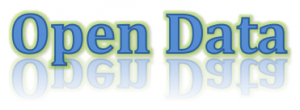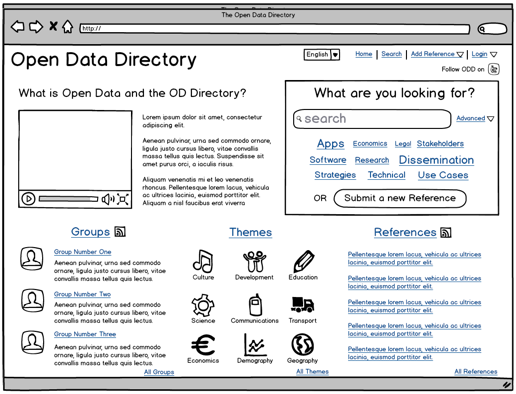Los planteamientos de Daniel Torres Burriel sobre cómo ve él las iniciativas Open Data desde su perspectiva de un diseñador, que son de lectura obligada para comprender lo que viene a continuación, me dan pie a iniciar una conversación sobre un tema que ya me había planteado en varias ocasiones: la relación entre el Open Data y el mundo de los diseñadores, así como las oportunidades de interacción y colaboración entre ambos.

Empiezo pues agradeciendo a Daniel el haber abierto el debate público sobre la materia y a continuación paso a expresar mis opiniones en cuanto a sus comentarios:
PDFs: El cementerio donde reposan los datos
Creo que nadie duda de ello, si bien es cierto que se sigue (y se seguirá) publicando información en PDF, mucha, claramente demasiada. El origen de este fenómeno suele ser que toda esa información normalmente ya estaba previamente en ese formato, ya que durante muchos años los PDFs fueron la forma cómoda (y pésima) de crear contenidos para las Webs de la Administración.
Pero, aunque siempre será algo mejor tener datos públicos en un mal formato que no tener ningún dato publicado, esto no debería ser tomado nunca como una solución definitiva, sino como una mera transición para publicar inmediatamente la información disponible a la vez que se trabaja en la mejora de esos formatos. El problema surge cuando lo que debería ser una solución (muy) temporal se convierte en el formato final y es entonces cuando los PDFs se convierten en el lugar a dónde van a morir los datos.
Modelos de representación de los datos
No tengo claro si he entendido bien el concepto de lo que propones como interfaz de consumo, por eso no estoy seguro de si es algo que realmente ya existe o algo que habría que hacer o si simplemente lo que pides es imposible.
Tal y como yo lo veo, cualquier dato que se exponga al final no es más que un dato, lo que al final sumará multitud de datos de las más variadas fuentes y dominios de información. Sí lo que pides es unas pautas generales de presentación de datos me atrevería a afirmar que eso es imposible más allá de todo el compendio que existe ya sobre el tratamiento general de la información y su visualización, pero eso también es una ciencia por sí misma que hay que saber aplicar en cada caso para saber sacarle partido a la información y aflorar las historias que esconde.
No hay más reglas ni puede haberlas. Si no lo he entendido bien por favor ayúdame a interpretarlo mejor, porque me encantaría poder buscarle una solución.
Los datos como entidades vivas
Sin lugar a dudas los datos son entidades vivas, y además existe cierta relación directa entre la frecuencia de actualización de los datos y su valor, es decir, generalmente los datos más vivos y que por su naturaleza se actualizan con mayor frecuencia son los que pueden aportar un mayor potencial en cuanto a beneficio social y económico.
Esa realidad se debe reflejar en los sistemas que gestionen los datos, pero el hecho de que un conjunto de datos se presente como fichero no quiere decir que ese datos estén condenados a la estaticidad de por vida. Al fin y al cabo un fichero tan solo refleja el estado de ese conjunto de datos en un momento determinado y por tanto podría ser también una solución válida aquella que aportase un fichero por cada versión de los datos, siempre que se combinase con un sistema adecuado de gestión de versiones, a través de una configuración apropiada de las URIs por ejemplo.
Cuestión aparte es que hay ciertos datos especialmente dinámicos a los que se les podría sacar mucho más partido a través de una API, e intuyo que por ahí van tus peticiones. En eso no puedo más que coincidir, con un algunos de matices:
- Una API podría no ser siempre la mejor opción.
- Para cumplir con los principios del Open Data esa API debería ser un complemento y nunca un sustituto del acceso completo a los datos en bruto.
- Habrá que seleccionar cuidadosamente cuáles son los datos que se abren por este medio, ya que crear y mantener una infraestructura que de soporte a ciertos datos especialmente dinámicos puede resultar bastante caro, y por supuesto estaríamos hablando de dinero público.
Patrones de datos
Nuevamente no se si el concepto de patrón de diseño se podría aplicar a la explotación de los datos, está claro que sí debe aplicarse, y de hecho ya se hace, para el diseño de los modelos de datos, pero precisamente el potencial de la explotación de los datos se basa en que no hay patrones establecidos y la creatividad y la imaginación con los que somos capaces de combinarlos son los únicos elementos que definen los límites.
Evidentemente para poder sacar provecho de esos datos habrá que tener ciertos conocimientos que provienen de distintas disciplinas (cálculo, estadística, bases de datos, algoritmos, programación, visualización, etc.) que en conjunto se vienen denominando Data Science, y por supuesto contando siempre también con especialistas de la materia en cuestión que se esté tratando en cada momento (sanidad, educación, transportes, medio ambiente, etc.)
Lo que si que es cierto es que en general existe una ausencia muy preocupante de los famosos “code books“ que deberían acompañar siempre a cualquier conjunto de datos para facilitar su explotación. Cuando tratamos con datos muy simples con estructuras mínimas es fácil que con poco esfuerzo cualquiera deduzca esas estructuras y pueda sacarles partido, pero en la mayoría de casos intentar hacer algo productivo con unos datos en crudo que no cuentan con ninguna documentación puede evolucionar fácilmente hacia una misión imposible, o cuando menos conllevará unos considerables esfuerzos superfluos que se podrían y deberían haberse evitado fácilmente.
La crítica final
Me alegra ver que todo el mundo esté últimamente ávido de datos, pero las iniciativas Open Data son carreras de fondo en la que hay que seguir una serie de pasos, entre los cuales se encuentra la necesidad de proporcionar un catálogo para que la información salga de los archivadores y los discos duros de la administración y se haga visible a todo el mundo.
Por muy poco acertada que pueda acabar siendo una iniciativa Open Data en su ejecución, que las hay, creo que llegar a compararlo con el despotismo ilustrado podría ser cuando menos un poco exagerado. Sobre todo si tenemos en cuenta que en este caso el Gobierno de Aragón lleva ya bastante tiempo trabajando tanto internamente, impartiendo formación a sus servidores públicos, como externamente llamando a la participación de todo el mundo, además de haber mostrado en repetidas ocasiones su voluntad de seguir haciéndolo en el futuro próximo.
Está claro que la colaboración entre todos los agentes implicados (Gobierno, Ciudadanos, Empresas, Profesionales, Universidad, etc.), incluyendo por supuesto a los diseñadores, es una herramienta fundamental para el éxito del Open Data, y por eso sería estupendo que el evento UX de referencia en España, al que acudirán muchos de esos diseñadores, adoptase un modelo más flexible, participativo e inclusivo,que las tradicionales conferencias y mesas redondas para abrirse más a la colaboración e intercambio de ideas con otros profesionales, como por ejemplo los del mundo del Open Data.
Personalmente me gustaría saber más sobre las inquietudes de diseñadores y profesionales de la UX acerca del Open Data, puesto que además ya forman parte de él cuando aplican RDFa, schema o microdatos a los diseños Web por ejemplo, pero es que si nunca hablamos, y cuando lo hacemos no es de forma constructiva, difícilmente nos vamos a poder entender.

